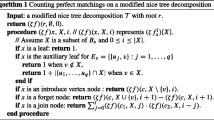Abstract
We consider dynamic evaluation of algebraic functions (matrix multiplication, determinant, convolution, Fourier transform, etc.) in the model of Reif and Tate; i.e., if f(x 1,..., x n ) = (y 1,..., y m ) is an algebraic problem, we consider serving on-line requests of the form “change input x i to value v” or “what is the value of output y i ?”. We present techniques for showing lower bounds on the worst case time complexity per operation for such problems. The first gives lower bounds in a wide range of rather powerful models (for instance history dependent algebraic computation trees over any infinite subset of a field, the integer RAM, and the generalized real RAM model of Ben-Amram and Galil). Using this technique, we show optimal Ω(n) bounds for dynamic matrix-vector product, dynamic matrix multiplication and dynamic discriminant and an Ω(√n) lower bound for dynamic polynomial multiplication (convolution), providing a good match with Reif and Tate’s O(√n log n) upper bound. We also show linear lower bounds for dynamic determinant, matrix adjoint and matrix inverse and an Ω(√n) lower bound for the elementary symmetric functions. The second technique is the communication complexity technique of Miltersen, Nisan, Safra, and Wigderson which we apply to the setting of dynamic algebraic problems, obtaining similar lower bounds in the word RAM model. The third technique gives lower bounds in the weaker straight line program model. Using this technique, we show an Ω((log n)2/log log n) lower bound for dynamic discrete Fourier transform. Technical ingredients of our techniques are the incompressibility technique of Ben-Amram and Galil and the lower bound for depth-two superconcentrators of Radhakrishnan and Ta-Shma. The incompressibility technique is extended to arithmetic computation in arbitrary fields.
Due to the space constraints imposed by these proceedings, in this version of the paper we only present the third technique, proving the lower bound for dynamic discrete Fourier transform and refer to the full version of the paper which is currently available as a BRICS technical report, for the rest of the proofs.
Full version of this paper is available as BRICS technical report RS-98-11 from the web site www.brics.dk
Supported by the ESPRIT Long Term Research Programme of the EU under project number 20244 (ALCOM-IT).
Access this chapter
Tax calculation will be finalised at checkout
Purchases are for personal use only
Preview
Unable to display preview. Download preview PDF.
Similar content being viewed by others
References
Amir M. Ben-Amram and Zvi Galil. Lower bounds for data structure problems on RAMs (extended abstract). In Proc. 32nd Annual Symposium on Foundations of Computer Science, pages 622–631, 1991.
Amir M. Ben-Amram and Zvi Galil. On pointers versus addresses. J. Assoc. Comput. Mach, 39:617–648, 1992.
M.L. Fredman. Lower bounds on the complexity of some optimal data structures. SIAM J. Comput., 10:1–10, 1981.
M.L. Fredman. The complexity of maintaining an array and computing its partial sums. J. Assoc. Comput. Mach., 29:250–260, 1982.
M.L. Fredman and M.E. Saks. The cell probe complexity of dynamic data structures. In Proc. Twenty First Annual ACM Symposium on Theory of Computing, pages 345–354, 1989.
M.L. Fredman and D.E. Willard. Surpassing the information-theoretic bound with fusion trees. J. Comput. System Sci., 47:424–436, 1993.
M.L. Fredman and D.E. Willard. Trans-dichotomous algorithms for mimimum spanning trees and shortest paths. J. Comput. System Sci., 48:533–551, 1994.
Torben Hagerup. Sorting and searching on the Word RAM. In Proc. 15th Annual Symposium on Theoretical Aspects of Computer Science, LNCS vol. 1373, pages 366–398. Springer-Verlag, 1998.
H. Hampapuram and M.L. Fredman. Optimal bi-weighted binary trees and the complexity of maintaining partial sums. In Proc. 34th Annual Symposium on Foundations of Computer Science, pages 480–485, 1993.
Thomas W. Hungerford. Algebra, volume 73 of Graduate Texts in Mathematics. Springer-Verlag, 1974.
G. H. Hardy and E. M. Wright. An Introduction to the Theory of Numbers. (Third Edition). Oxford University Press, 1954.
Roy Meshulam. A geometric construction of a superconcentrator of depth 2. Theoret. Comput. Sci., 32:215–219, 1984.
Peter Bro Miltersen, Noam Nisan, Shmuel Safra, and Avi Wigderson. On data structures and asymmetric communication complexity. In Proc. 27th Annual ACM Symposium on the Theory of Computing, pages 103–111, 1995.
John H. Reif and Stephen R. Tate. On dynamic algorithms for algebraic problems. J. Algorithms, 22:347–371, 1997.
Jaikumar Radhakrishnan and Amnon Ta-Shma. Tight bounds for depth-two superconcentrators. In Proc. 38th Annual Symposium on Foundations of Computer Science, pages 585–594, 1997.
J.E. Savage. An algorithm for the computation of linear forms. SIAM J. Comput., 3:150–158, 1974.
Leslie G. Valiant. Graph-theoretic properties in computational complexity. Journal of Computer and System Sciences, 13(3):278–285, December 1976.
S. Winograd. On the number of multiplications required to compute certain functions. Proc. Nat. Acad. Sci. U.S.A., 58:1840–1842, 1967.
S. Winograd. On the number of multiplications necessary to compute certain functions. Comm. Pure Appl. Math., 23:165–179, 1970.
A.C. Yao. On the complexity of maintaining partial sums. SIAM J. Comput., 14:277–288, 1985.
Author information
Authors and Affiliations
Editor information
Editors and Affiliations
Rights and permissions
Copyright information
© 1999 Springer-Verlag Berlin Heidelberg
About this paper
Cite this paper
Frandsen, G.S., Hansen, J.P., Miltersen, P.B. (1999). Lower Bounds for Dynamic Algebraic Problems. In: Meinel, C., Tison, S. (eds) STACS 99. STACS 1999. Lecture Notes in Computer Science, vol 1563. Springer, Berlin, Heidelberg. https://doi.org/10.1007/3-540-49116-3_34
Download citation
DOI: https://doi.org/10.1007/3-540-49116-3_34
Published:
Publisher Name: Springer, Berlin, Heidelberg
Print ISBN: 978-3-540-65691-3
Online ISBN: 978-3-540-49116-3
eBook Packages: Springer Book Archive




